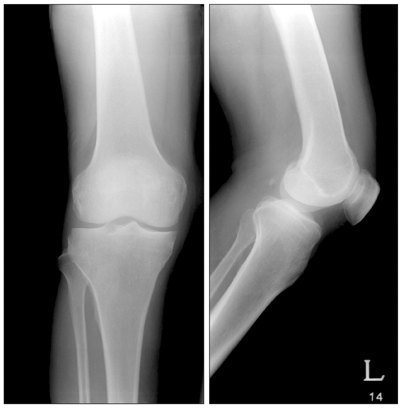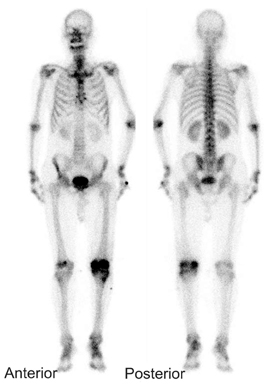Clin Orthop Surg.
2010 Mar;2(1):59-62. 10.4055/cios.2010.2.1.59.
A Case of Fungal Arthritis Caused by Hansenula Anomala
- Affiliations
-
- 1Department of Orthopedic Surgery, Cheju National University Hospital, Jeju, Korea.
- 2Department of Orthopedic Surgery, Inha Hospital, Incheon, Korea. tjlee@inha.ac.kr
- KMID: 1110351
- DOI: http://doi.org/10.4055/cios.2010.2.1.59
Abstract
- Hansenula anomala (H. anomaly) is part of the normal flora in the alimentary tract and throat. It has been reported to be an organism causing opportunistic infections in immunocompromised patients. However, cases of fungal arthritis caused by H. anomala are rare. We encountered a case of H. anomala arthritis in a 70-year-old man who was treated with an empirical antibiotic treatment and surgery under the impression of septic arthritis. However, the patient did not improve after antibiotic therapy and surgery. Consequently, knee joint aspiration was performed again, which identified fungal arthritis caused by H. anomala. It was treated successfully with amphotericin B and fluconazole. When treating arthritis patients with diabetes, it is important to consider the possibility of septic arthritis by H. anomala and provide the appropriate treatment.
Keyword
MeSH Terms
Figure
Reference
-
1. Haron E, Anaissie E, Dumphy F, McCreie K, Fainstein V. Hansenula anomala fungemia. Rev Infect Dis. 1988. 10(6):1182–1186.
Article2. Choi HS, Choi TY. Analysis of 22 cases of Fungemia due to Hansenula anomala. Korean J Clin Pathol. 1996. 16(2):201–210.3. Murphy N, Buchanan CR, Damjanovic V, Whitaker R, Hart CA, Cooke RW. Infection and colonisation of neonates by Hansenula anomala. Lancet. 1986. 1(8476):291–293.
Article4. Park SS, Lee SH, Lee MA, Hong KS. Hansenula anomala pneumonia in a patient with lung cancer. Korean J Clin Pathol. 1994. 14(4):463–469.5. Ma JS, Chen PY, Chen CH, Chi CS. Neonatal fungemia caused by Hansenula anomala: a case report. J Microbiol Immunol Infect. 2000. 33(4):267–270.6. Taylor GD, Buchanan-Chell M, Kirkland T, McKenzie M, Wiens R. Trends and sources of nosocomial fungaemia. Mycoses. 1994. 37(5-6):187–190.
Article7. Vicari P, Feitosa Pinheiro R, Chauffaille Mde L, Yamamoto M, Figueiredo MS. Septic arthritis as the first sign of Candida tropicalis fungaemia in an acute lymphoid leukemia patient. Braz J Infect Dis. 2003. 7(6):426–428.
Article8. Klein JJ, Watanakunakorn C. Hospital-acquired fungemia: its natural course and clinical significance. Am J Med. 1979. 67(1):51–58.9. Klein AS, Tortora GT, Malowitz R, Greene WH. Hansenula anomala: a new fungal pathogen. Two case reports and a review of the literature. Arch Intern Med. 1988. 148(5):1210–1213.
Article10. Cuellar ML, Silveira LH, Espinoza LR. Fungal arthritis. Ann Rheum Dis. 1992. 51(5):690–697.
Article
- Full Text Links
- Actions
-
Cited
- CITED
-
- Close
- Share
- Similar articles
-
- A Diabetic Patient with Fungal Arthritis due to Hansenula anomala
- A Case of Pichia anomala Detected Incidentally in Peripheral Blood Smear
- A Case of Visual Loss Caused by Invasive Fungal Sinusitis of the Onodi Cell
- A Case of Melanonychia Caused by Trichophyton rubrum
- Pneumonia with Empyema Caused by Cladosporium velox in a Patient with Rheumatoid Arthritis




